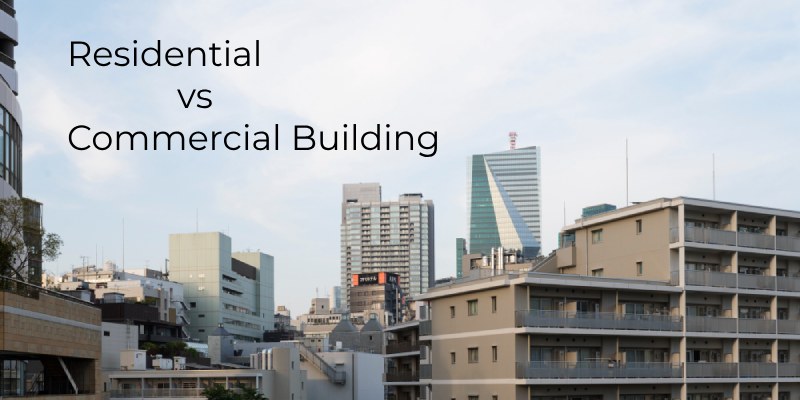When it comes to construction and real estate, understanding the differences between residential vs commercial building is crucial. Whether you’re a homeowner, a business owner, or an investor, knowing these distinctions can guide your decisions and investments. This article will explore the difference between residential and commercial building, covering everything from design and construction materials to market demand and investment potential.
Definition: Residential vs Commercial Building
Before we dive into the details, let’s start by understanding what the differences between Residential vs Commercial Building are.
Definition of Residential Buildings
Residential buildings are structures intended for people to live in. These buildings are designed with comfort, safety, and privacy in mind, catering to the needs of individuals and families. They typically include amenities such as kitchens, bathrooms, and bedrooms, ensuring a functional living environment.
Types of Residential Buildings
Residential buildings come in various forms, including single-family homes, multi-family homes, apartments, and condominiums. Each type offers different living experiences and caters to various preferences and budgets.
Definition of Commercial Buildings
Commercial buildings are designed to support business activities. They focus on functionality, accessibility, and accommodating large numbers of people. These buildings often feature open floor plans, extensive lighting, and specialized infrastructure to support business operations.
Types of Commercial Buildings
Commercial buildings encompass a wide range of structures, including office buildings, retail spaces, warehouses, and industrial facilities. Each type serves specific business needs and operates under different requirements and regulations.
Difference Between Residential and Commercial Building
Let’s explore 6 Key differences between residential vs commercial building:
Purpose and Use
The primary purpose of residential buildings is to provide safe and comfortable living spaces. These buildings are designed to meet the daily needs of residents, offering privacy and personal space.
Commercial buildings, on the other hand, are used for business operations. They house various businesses, from small shops to large corporations, facilitating commerce, services, and industrial activities.
Design and Architecture
Residential design prioritizes comfort and aesthetics. Common features include cozy living areas, well-equipped kitchens, and private outdoor spaces. Architectural styles can range from modern and minimalist to traditional and ornate, reflecting personal tastes and cultural influences.
Commercial design focuses on functionality and efficiency. These buildings often have open floor plans to accommodate different business needs, extensive lighting for safety and visibility, and robust infrastructure to support technological and operational requirements.
Construction Materials
Residential buildings typically use materials like wood, brick, concrete, and steel. The choice of materials often depends on factors like climate, budget, and architectural style. Wood is common for its versatility and aesthetic appeal, while brick and concrete offer durability and thermal efficiency.
Commercial buildings frequently use steel, concrete, and glass. These materials provide the strength and flexibility needed for large-scale structures. Steel is preferred for its high strength-to-weight ratio, while glass is used extensively for its aesthetic and natural lighting benefits.
Building Codes and Regulations
Residential buildings must comply with local building codes that ensure safety, health, and energy efficiency. These regulations cover aspects like electrical systems, plumbing, structural integrity, and fire safety. Compliance is essential to protect the well-being of residents and maintain property value.
Commercial building codes are typically more stringent due to the higher occupancy rates and varied uses of these buildings. Regulations address issues such as accessibility, fire safety, structural stability, and environmental impact. Adherence to these codes is crucial to ensure the safety of employees, customers, and the general public.
Cost Differences
The cost of constructing residential buildings varies widely based on factors like location, size, materials, and design complexity. On average, building a single-family home is less expensive per square foot than a commercial building. However, high-end custom homes can be quite costly.
Commercial construction costs are generally higher due to the need for specialized materials, advanced infrastructure, and compliance with stringent building codes. Factors such as the building’s intended use, location, and size significantly influence the overall cost.
Maintenance Requirements
Maintaining residential properties involves routine tasks like cleaning, landscaping, and minor repairs. Homeowners may also need to address larger issues such as roof repairs, plumbing, and electrical system maintenance. Regular upkeep is vital to preserve the home’s value and livability.
Commercial buildings require more extensive maintenance due to their size and complexity. This includes HVAC system upkeep, elevator maintenance, exterior cleaning, and safety inspections. Commercial property owners often hire professional management companies to handle these tasks efficiently.
Energy Efficiency
Energy efficiency in residential buildings is achieved through insulation, energy-efficient windows, and modern HVAC systems. Homeowners are increasingly adopting renewable energy sources like solar panels to reduce utility costs and environmental impact.
Commercial buildings implement energy efficiency through advanced systems such as automated lighting, high-efficiency HVAC systems, and green building certifications like LEED. These measures not only reduce operational costs but also enhance the building’s appeal to environmentally conscious businesses.
Safety and Security
Residential safety focuses on protecting occupants from hazards like fire, carbon monoxide, and break-ins. Common features include smoke detectors, security systems, and sturdy locks. Building codes also mandate specific safety standards to safeguard residents.
Commercial buildings incorporate extensive safety measures to protect large numbers of occupants. This includes fire sprinkler systems, emergency exits, surveillance cameras, and security personnel. Compliance with OSHA regulations and local safety codes is essential to ensure a safe environment.
Market Demand and Value
The demand for residential properties is influenced by factors such as population growth, economic conditions, and interest rates. Residential real estate typically experiences steady demand, with market fluctuations driven by broader economic trends and local factors.
Commercial real estate demand is tied to business growth, economic cycles, and market trends. Factors such as location, infrastructure, and economic outlook play significant roles in determining the value and demand for commercial properties.
Investment Potential
Residential properties are often considered a stable investment due to consistent demand. Investors benefit from rental income, property appreciation, and tax advantages. Single-family homes, duplexes, and multi-family units are popular choices for real estate investors.
Commercial properties offer higher income potential and longer lease terms compared to residential properties. However, they also come with greater risks and higher management demands. Successful commercial real estate investments require thorough market research and strategic planning.
Financing Options
Residential building financing options include conventional mortgages, FHA loans, VA loans, and home equity loans. Lenders assess factors such as credit scores, income, and debt-to-income ratios when approving loans for residential properties.
Commercial real estate financing involves more complex arrangements. Options include commercial mortgages, SBA loans, bridge loans, and crowdfunding. Lenders evaluate the property’s income potential, location, and the borrower’s business history and financial health.
Conclusion
Understanding the Difference Between Residential and Commercial Building is essential for anyone involved in construction, real estate, or investment. While both types of buildings serve distinct purposes, they differ significantly in design, construction materials, regulatory requirements, and market dynamics. Whether you’re planning to build, buy, or invest, being informed about these differences can help you make better decisions and achieve your goals.
FAQs
What are the main differences between residential vs commercial buildings?
Residential buildings are designed for living spaces, while commercial buildings are meant for business operations. They differ in design, construction materials, building codes, and costs.
Which type of building is more expensive to construct?
Commercial buildings are generally more expensive to construct due to the need for specialized materials, infrastructure, and compliance with stringent building codes.
Are building codes stricter for commercial buildings?
Yes, commercial building codes are typically more stringent due to higher occupancy rates and varied uses, addressing accessibility, fire safety, structural stability, and environmental impact.
How do maintenance requirements differ?
Residential maintenance involves routine tasks like cleaning and minor repairs, while commercial maintenance requires more extensive upkeep of systems like HVAC, elevators, and safety inspections.
What factors should investors consider?
Investors should consider factors such as location, market demand, cost, potential returns, and specific risks associated with residential and commercial properties.






